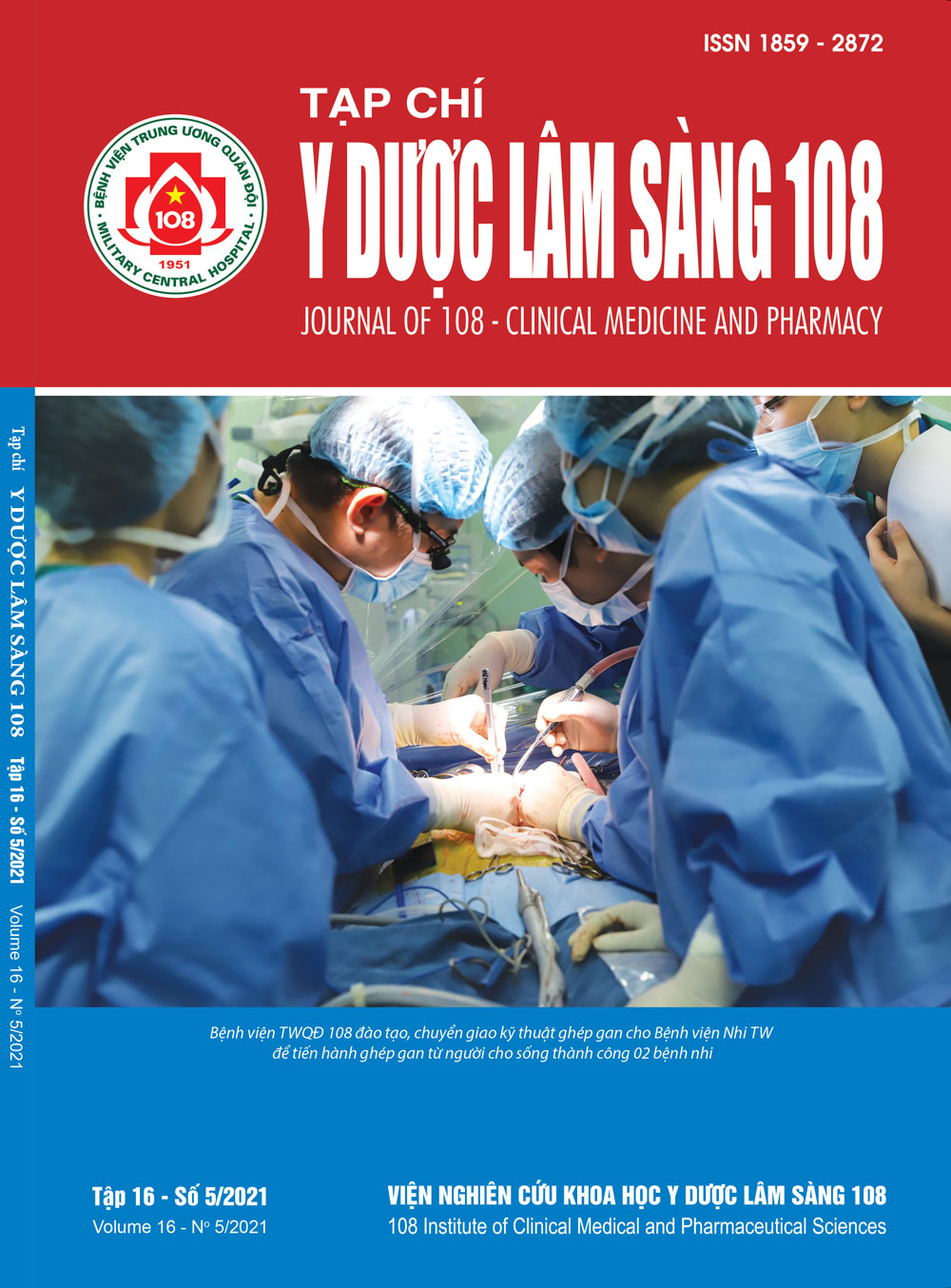Đánh giá kết quả can thiệp nhồi máu não cấp nhánh lớn do bệnh lý động mạch cảnh ngoài sọ
Main Article Content
Keywords
Tóm tắt
Mục tiêu: Đánh giá đặc điểm tổn thương bệnh lý động mạch cảnh ngoài sọ gây nhồi máu não cấp nhánh lớn. Tính hiệu quả, mức độ an toàn cũng như khả năng phục hồi về mặt lâm sàng của người bệnh sau can thiệp. Đối tượng và phương pháp: Gồm 46 bệnh nhân đột quỵ nhồi máu não cấp do tổn thương động mạch cảnh đoạn ngoài sọ được can thiệp lấy huyết khối bằng dụng cụ cơ học từ tháng 01/2018 đến tháng 12/2020. Phương pháp nghiên cứu hồi cứu, mô tả, theo dõi dọc. Kết quả: Tuổi trung bình trong nhóm nghiên cứu là 62,83 ± 13,03 năm. Nam giới 87%. Lâm sàng bệnh nhân khi vào viện Glasgow 12,65 ± 2,3, NIHSS 15,02 ± 5,58, ASPECT 8,45 ± 1,33. Thời gian vào viện đến khi chọc động mạch đùi 65,87 ± 14,43 phút. Thời gian can thiệp 41,52 ± 32,95. Tổn thương tắc đa tầng (tandem) chiếm 58,7%, mức độ tắc hoàn toàn 67,4%. Đặt stent thành công cho 43/44 (97,8%), 01 trường hợp nong bóng đơn thuần, 1 trường hợp hybrid. Dòng chảy sau can thiệp 100% TICI 2b/3. Chảy máu dưới nhện do tai biến kỹ thuật 1 trường hợp, chảy máu chuyển thể 3 trường hợp. Tử vong do mọi nguyên nhân 13,5%. Phục hồi về thần kinh tại thời điểm sau can thiệp theo thang điểm NIHSS đạt 86,5%. Mức độ phục hồi về lâm sàng ở mức tốt (di chứng đột quỵ nhẹ) mRS 0 - 2 đạt 70%. Kết luận: Bệnh lý tổn thương động mạch cảnh ngoài sọ chủ yếu do vữa xơ mạch máu gây nhồi máu não. Can thiệp nội mạch mang lại tỷ lệ tái thông cao, tai biến và tử vong ở mức cho phép. Bệnh nhân sau can thiệp có phục hồi về lâm sàng và thần kinh tốt.
Article Details
Các tài liệu tham khảo
2. Petr Widimsky BK, Mark Abelson, Peter Blaškog, Peter Lanzer, MikaelMazighi, Martijn Meuwissen, Václav Procházkae, Horst Sievert, Joostde Vriesj, NelsonHopkins L (2016) Stent or balloon: How to treat proximal internal carotid artery occlusion in the acute phase of ischemic stroke? Results of a short survey. Cor et Vasa 58(2): 204-206.
3. Saqqur M et al (2007) Site of arterial occlusion identified by transcranial Doppler predicts the response to intravenous thrombolysis for stroke. Stroke 38(3): 948-954.
4. Goldstein LB, Bertels C, and Davis JN (1989) Interrater reliability of the NIH stroke scale. Arch Neurol 46(6): 660-662.
5. Pexman JH, Barber PA, Hill MD, Sevick RJ, Demchuk AM, Hudon ME, Hu WY, Buchan AM (2001) Use of the Alberta Stroke Program Early CT Score (ASPECTS) for assessing CT scans in patients with acute stroke. AJNR Am J Neuroradiol 22(8): 1534-1542.
6. Barnett HJ et al (1998) Benefit of carotid endarterectomy in patients with symptomatic moderate or severe stenosis. North American symptomatic carotid endarterectomy trial collaborators. N Engl J Med 339(20): 1415-1425.
7. Zaidat OO et al (2013) Recommendations on angiographic revascularization grading standards for acute ischemic stroke: A consensus statement. Stroke 44(9): 2650-2663.
8. Choi JY et al (2014) Emergent recanalization with stenting for acute stroke due to athero-thrombotic occlusion of the cervical internal carotid artery: A single center experience. J Korean Neurosurg Soc 55(6): 313-320.
9. Brott TG et al (2010) Stenting versus endarterectomy for treatment of carotid-artery stenosis. N Engl J Med 363(1): 11-23.
10. Kan P et al (2012) Cervical carotid artery stenosis: Latest update on diagnosis and management. Curr Probl Cardiol 37(4): 127-169.
11. Inzitari D et al (2000) The causes and risk of stroke in patients with asymptomatic internal-carotid-artery stenosis. North American Symptomatic Carotid Endarterectomy Trial Collaborators. N Engl J Med 342(23): 1693-700.
12. Rothwell PM and Warlow CP (2000) Low risk of ischemic stroke in patients with reduced internal carotid artery lumen diameter distal to severe symptomatic carotid stenosis: Cerebral protection due to low poststenotic flow? On behalf of the European Carotid Surgery Trialists' Collaborative Group. Stroke 31(3): 622-630.
13. Goodfriend SD, Tadi P, and Koury R (2021) Carotid artery dissection, in StatPearls. Treasure Island (FL).
14. Park SE et al (2018) Endovascular therapy of acute ischemic stroke related to tandem occlusion: Comparison of occlusion and severe stenosis of the proximal cervical internal carotid artery. Br J Radiol: 20180051.
15. Lockau H et al (2015) Mechanical thrombectomy in tandem occlusion: Procedural considerations and clinical results. Neuroradiology 57(6): 589-598.
16. Zoppo GJ et al (1992) Recombinant tissue plasminogen activator in acute thrombotic and embolic stroke. Ann Neurol 32(1): 78-86.
17. Nguyễn Quang Anh, Vũ Đăng Lưu, Trần Anh Tuấn và cộng sự (2013) Đánh giá hiệu quả bước đầu phương pháp lấy huyết khối bằng stent solitaire ở bệnh nhân nhồi máu não tối cấp. Tạp chí Điện quang số 14, tr. 226-232.
18. Wilson MP et al (2018) Management of tandem occlusions in acute ischemic stroke - intracranial versus extracranial first and extracranial stenting versus angioplasty alone: A systematic review and meta-analysis. J Neurointerv Surg 10(8): 721-728.
19. Vu-Dang L et al (2020) Endovascular treatment for acute tandem occlusion stroke: results from case series of 17 patients. Ann Indian Acad Neurol 23(1): 78-83.
 ISSN: 1859 - 2872
ISSN: 1859 - 2872
